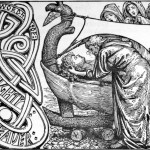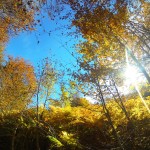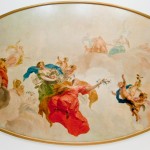So spring has arrived. It’s beautiful. We have our windows open. Just in time for the spring equinox. Not that we won’t have one last freeze in the next few weeks, like nature’s own Walpurgis Night — the last ride of the spirits of winter. Nature is a tease.
And right on time, my allergies are back. Yesterday I was walking around in a fog — and not one produced by allergy medication. I have yet to break out my antihistamine stash. When I can’t breathe, this invisible film forms on the world which dulls all my senses. The very thing that draws me closest to divinity, the natural world, is also the thing that sabotages my efforts to draw close to it.
I just read this disturbing story that Annie Dillard wrote in her Pilgrim at Tinker Creek:
Is beauty itself an intricately fashioned lure, the cruelest hoax of all? There is a certain fragment of an ancient and involved Eskimo tale I read in Farley Mowat that for years has risen, unbidden, in my mind. The fragment is a short scenario, observing all the classical unities, simple and cruel, and performed by the light of a soapstone seal-oil lamp.
A young man in a strange land falls in love with a young woman and takes her to wife in her mother’s tent. By day the women chew skins and boil meat while the young man hunts. But the old crone is jealous; she wants the boy. Calling her daughter to her one day, she offers to braid her hair; the girl sits pleased, proud, and soon strangled by her own hair. One thing Eskimos know is skinning. The mother takes her curved hand knife shaped like a dancing skirt, skins her daughter’s beautiful face, and presses that empty flap smooth on her own skull. When the boy returns that night he lies with her, in the tent on top of the world. But he is wet from hunting; the skin mask shrinks and slides, uncovering the shriveled face of the old mother, and the boy flees in horror, forever.
Could it be that if I climbed the dome of heaven and scrabbled and clutched at the beautiful cloth till I loaded my fists with a wrinkle to pull, that the mask would rip away to reveal a toothless old ugly, eyes glazed with delight?
That’s a vivid image! Dillard’s book is a wonderful study of the coexistence of beauty and horror in nature. I like this story in particular, disturbing as it is, because it invokes those Neopagan motifs of the “Triple Goddess”, maiden, mother, and crone (or, to use Robert Graves’ term which seems more appropriate in this case, “hag”). There are some days when the beauty of the world does feel like a cruel trick and nature seems to stare at me like “a toothless old ugly, eyes glazed with delight”. Today, she is more like a maiden, but with the a veil drawn across her.
I need to go take a pill …















